Regarding hair care, one of the terms you probably ran into is hair porosity, which refers to hair’s ability to absorb and retain moisture. Understanding your hair porosity will be key to getting the right products and techniques for healthy, vibrant hair.
What Is Hair Porosity?
This is determined by the state of the cuticle, the outer layer of every hair strand. If the cuticle is raised and porous, the moisture freely enters and leaves the hair. Conversely, if the cuticle is closed and smooth, moisture will stay locked in.
There are three main types of porosity:
1:Low Porosity
Low porosity has a hard and smooth-cuticle layer that lies very flat. This way, moisture doesn’t escape so easily, but it also makes it difficult for products to penetrate into the strands. Low porosity hair is generally shiny, however; it can be quite difficult to hydrate or get it to absorb moisture.
How to identify:
- Products tend to sit on top of hair rather than absorbing in.
- It takes longer for hair to dry after washing.
- It may feel greasy or weighed down if too much product is applied
Care tips
- Use heat (like a hooded dryer or heat cap) to get your cuticle to open and let it absorb the products.
- Use lightweight, water-based products.
- Avoid heavy oils and creams, they will only weigh hair down
2 :Medium (Normal) Porosity
Essentially, it has a balanced cuticle that is not too tightly closed nor too opened. Such hair absorbs and holds on to moisture, which makes maintenance minimal and styling a bit easier.
How to identify:
- Moisturizers and treatments penetrate fairly easily.
- Hair dries at a normal pace.
- Styles won’t usually hold well.
Best care tips:
- Keeping a steady routine of doing a combo of moisturizing and protein treatments
- Protect from nature, like the sun or pollutants
- Use products that nourish without weighing your hair down
3 :High porosity
High porosity hair has openings or holes in the cuticle, which allow water to enter and leave very quickly. This means that while your hair transports product and moisture quickly, it also loses moisture just as fast; hence, it may often have a dryness or damage tendency.
How to identify
- The hair feels coarse or dry when you touch it
- The water absorbs fast and evaporates quickly, leaving the hair dry
- It can knot easily and be more prone to frizzy surfaces.
Best care tips:
- Use heavier oils, creams, and butter-based products to lock in moisture.
- Deep-conditioned treatments or protein treatments should be done to seal in moisture.
- The exposure to hot styling tools should be minimized to combat any further defeat
How You Can Determine Hair Porosity
There are a few ways you can check your hair porosity at home:
The Float Test: Take a clean, dry strand of hair and place it in a glass of water. If it sinks really fast, it is likely high porosity; if it floats or takes a bit of time to sink, your hair is likely low porosity; if the hair floats for a while and then sinks slowly, it is likely you have medium porosity hair.
The Slide Test: Take a damp strand of hair and go from the ends to the root with the fingers. If that moves smoothly, your hair is likely low porosity. If you see bumps or ridges while doing this, your hair might be high porosity.
The absorption test: Squeeze a section of damp hair, which you’ve spritzed with water. If the water beads and collects on the surface, it is said that the hair is low porosity. If it sinks quickly, it is definitely high porosity. If it stays wet only on the outer dry ends, then it is in the possibly medium porosity category.
Conclusion
Understanding your porosity is imperative to ensure that you are using the right products and right techniques on your hair. Hence, with this knowledge of how your hair absorbs or retains moisture, you will be able to provide catered care to the hair in order to maintain its healthy, moist, and shiny status. Low, medium, and high porosity hair each has a specific regimen and product that will work for it, only if you pay attention.



